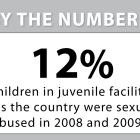
Some alarming numbers about children who are sexually abused while in custody are contained in a letter sent to U.S. Attorney General Eric Holder on May 10, 2010 from seven national advocacy groups. The Children’s Defense Fund, Campaign for Youth Justice, Youth Law Center and other groups created a report called Preventing the Sexual Abuse of Youth in Correctional Settings. Some of their recommendations:
Training in adolescent development for people who work or volunteer in youth facilities. More direct supervision by trained adults instead of video surveillance. Assessment standards and safety plans to keep vulnerable children safe. Limiting harsh responses to consensual sex between residents, where it may not be abusive
The report contains current federal laws, plus information about the new Juvenile Justice and Delinquency Prevention Act currently under review in Congress. It also features research, questionnaires, and resolutions from the PTA, the American Bar Association, the NAACP and other organizations concerned about the risks of placing juveniles under 18 in adult prisons. See more numbers here.








